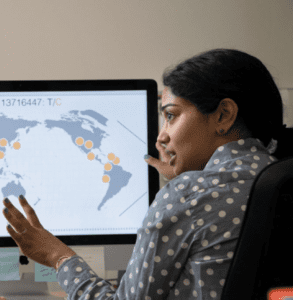Posted By: Sara Cullinan, PhD, Deputy Editor, AJHG
Each month, the editors of The American Journal of Human Genetics interview an author of a recently published paper. This month we check in with Sohini (@s_ramach) to discuss her paper “Enrichment analyses identify shared associations for 25 quantitative traits in over 600,000 individuals from seven diverse ancestries.”
SC: What motivated you to start working on this project?s

SR: The seeds of this project were actually planted in 2009 when I gave a seminar at St. Jude Children’s Research Hospital and learned about work they were doing on differential relapse rates for children with acute lymphoblastic leukemia by ancestry, despite very standardized therapeutic regimens (At the time, there were only very small rumblings about whether the results from genome-wide association studies (GWAS) would extrapolate across ancestries. It was then that I began wondering whether GWAS would actually benefit all people equally. Around 2016, I became curious about why the GWAS framework has maintained popularity. The goal of a GWAS is very specific: it is meant to generate hypotheses about individual mutations associated with a trait of interest. But for traits that might have genetic heterogeneity (be caused by different mutations in different cases) or that might involve multiple genes or pathways working in concert, this seemed like a very restrictive biological hypothesis. So my group started, in collaboration with Ben Raphael (then at Brown and now at Princeton) and also with Jun Yang from St. Jude and Philip Lupo from Baylor College of Medicine, to develop and apply gene-level association methods, and then I became interested in applying these approaches at scale to large biobanks using methods my group developed with my colleague Lorin Crawford.
SC: What about this paper/project most excites you?
SR: I think there are two exciting takeaways from this project. First, we don’t need to leave data on the table when studying the genetic basis of trait architecture in large biobanks. A hidden gem in this paper is our analysis of how many studies using the UK Biobank, based on scraping PubMed abstracts, only analyze the “white British” cohort. This should no longer be acceptable in our research community, at least not without lengthy explanations as to why focusing on just one ancestry in analysis is appropriate. Even if no statistically significant results present themselves, conducting and releasing analyses for full datasets should be a priority for the research community. Second, I think this study highlights the role methods can play in making medical genetics research beneficial for all. While we do need to diversity datasets, that alone is not going to make genomics research relevant to all.
SC: Thinking about the bigger picture, what implications do you see from this work for the larger human genetics community?
SR: My hope is that we will start realizing that there is incredible value in analyzing diverse genomes jointly, versus focusing on higher and higher quality datasets for individuals of European ancestry. Much of our understanding of important traits in medicine and evolution, such as blood-related traits or lactose tolerance, came from studying individuals of non-European ancestry. I think, in the era of biobanks, it would be interesting for the human genetics community to weigh the benefits of small studies of diverse individuals against increasingly sampling already well-represented groups.
SC: What advice do you have for trainees/young scientists?
SR: Research and trying to innovate creatively as a scientist can be very difficult at times, and it is common for academics (really, for everyone) to look around and feel like everyone else seems so confident and sure of themselves. My advice is to lean into those feelings of impostor syndrome and flip those into goals: situations that make us question our abilities can point to areas in which we can and should grow our skills.
SC: And for fun, tell us something about your life outside of the lab.\
SR: I have three small kids, who are 9, 5.5, and about to be 1. Their curiosity is inspiring on a daily basis, although I don’t know enough science or natural history to satisfy their questions! Now that our youngest is moving into toddler-hood, I’m looking forward to returning to my hobbies: knitting sweaters and running in Providence with my colleagues Emilia Huerta-Sanchez and Ritambhara Singh.
